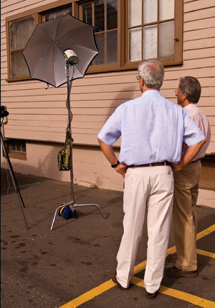JTL’s Mobilight DC-600; Have Light, Will Travel
The kind of photography I do can take me almost anywhere. Today I could be
photographing in my studio, tomorrow on the streets. I can often "get
away" with available light or a Speedlite mounted on a flash bracket--and
sometimes I do just that. But getting away with something is not always the
best way to get the results my clients need.
On location assignments I invariably take one or two monolights and Avenger
C-stands with me. If I am able to access a wall socket I most often choose to
use them over the often more expedient flash-on-bracket. But even with extension
cords I have found that this is not always feasible or possible. An example
that immediately comes to mind is bathing suit photographs on location, something
I was often called on to do when I had a studio in Hollywood, California. There
aren't a lot of wall sockets in the sand on Malibu Beach--and if
there are I never found them.
 |
|
|
Well, I'm not in Hollywood anymore; I'm in the mini-megalopolis
of Salem, Oregon. Many of my assignments take me on location around the city.
Renting a generator for these outdoor locations is not an option--the budget
for the local wine merchant who needs a promo piece isn't the same as
it is for advertising agencies in Los Angeles.
So, what do you do when you find yourself outside without a generator? I was
recently approached to test a new studio light made by JTL. I was told it was
entirely digitalized and ran off a portable battery pack. This interested me
for two reasons. First, I did not have a clue what a digitalized light was and,
second, with as much location work as I have been doing in Salem the idea of
a studio-quality light that didn't need an extension cord was appealing.
It turns out that by "digitalized" JTL means the light is entirely
controlled by an internal computer with three distinct programs for the various
functions. The lights I am accustomed to using, and probably you are, too, are
controlled by mechanical means, potentiometers and slider switches to increase
or decrease light output, and so on. By digitizing the controls they are 100
percent accurate and repeatable. In other words, if you set a power output on
the LCD screen to say, a level of 398, it will always produce exactly the same
amount of light at that setting. Contrast this to a slider. You move it to the
1/2 stop position, but the next time will you be able to move it to precisely
the same position? I have had that problem with the lights I use. Although the
variation may be minor, when I'm attempting to adjust the lighting ratio,
especially for close-up tabletop work, I like to be able to get back to my last
output level as closely as possible. That kind of precision may be a small matter,
but it is nice to know that it is available.
 |
|
|
Another feature of the DC-600 is the Digital Remote Receiver (DRR) and Digital
Remote Controller (DRC). By mounting a DRR on the back of each light and pointing
the rotating face toward the camera position it is possible to use the DRC to
change the power output on individual lights to control the ratio, pre-flash
the light, and other functions. Due to the large LCD, the information displayed
on the DRR (power output and the channel the unit is on, 1-9) can be seen from
yards away even in bright sunlight. One DRR comes bundled with each lamp head.
The DRC, which increases the DRR's functionality, is available as an optional
accessory though only one is required to control up to nine lamp heads.
- Log in or register to post comments

































